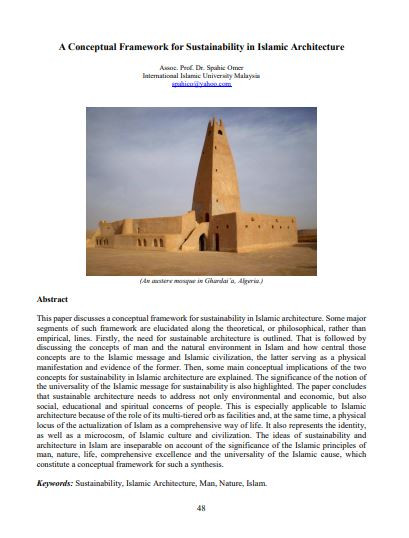
This paper discusses a conceptual framework for sustainability in Islamic architecture. Some major segments of such framework are elucidated along the theoretical, or philosophical, rather than empirical, lines. Firstly, the need for sustainable architecture is outlined. That is followed by discussing the concepts of man and the natural environment in Islam and how central those concepts are to the Islamic message and Islamic civilization, the latter serving as a physical manifestation and evidence of the former. Then, some main conceptual implications of the two concepts for sustainability in Islamic architecture are explained. The significance of the notion of the universality of the Islamic message for sustainability is also highlighted. The paper concludes that sustainable architecture needs to address not only environmental and economic, but also social, educational and spiritual concerns of people. This is especially applicable to Islamic architecture because of the role of its multi-tiered orb as facilities and, at the same time, a physical locus of the actualization of Islam as a comprehensive way of life. It also represents the identity, as well as a microcosm, of Islamic culture and civilization. The ideas of sustainability and architecture in Islam are inseparable on account of the significance of the Islamic principles of man, nature, life, comprehensive excellence and the universality of the Islamic cause, which constitute a conceptual framework for such a synthesis.
I agree to the terms outlined below:
You agree to upload and assign Mosqpedia Database the rights to use the content worldwide and in perpetuity across all current and future media platforms. Mosqpedia Database may edit, copy, adapt and translate your contribution.
The content will be distributed under the Creative Commons Attribution-Deed – Attribution-NonCommercial-NoDerivatives 4.0 International – Creative Commons
All data will be stored in line with data protection regulations.